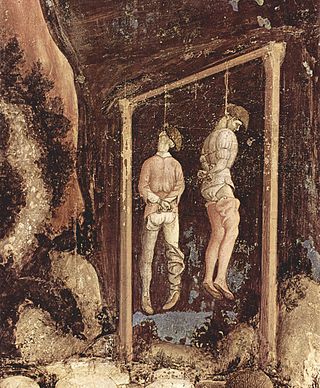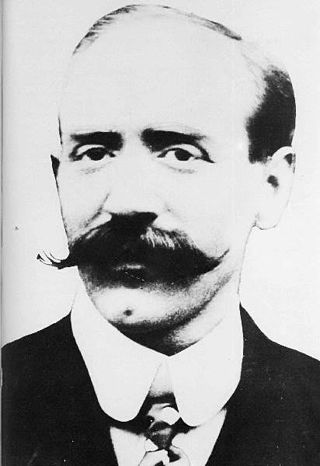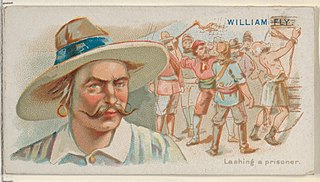
Tyburn was a manor (estate) in the county of Middlesex, England, one of two which were served by the parish of Marylebone. Tyburn took its name from the Tyburn Brook, a tributary of the River Westbourne. The name Tyburn, from Teo Bourne, means 'boundary stream'.

Hanging is killing a person by suspending them from the neck with a noose or ligature. Hanging has been a common method of capital punishment since the Middle Ages, and is the primary execution method in numerous countries and regions. The first known account of execution by hanging is in Homer's Odyssey. Hanging is also a method of suicide.

Albert Pierrepoint was an English hangman who executed between 435 and 600 people in a 25-year career that ended in 1956. His father Henry and uncle Thomas were official hangmen before him.

Capital punishment in the United Kingdom predates the formation of the UK, having been used within the British Isles from ancient times until the second half of the 20th century. The last executions in the United Kingdom were by hanging, and took place in 1964; capital punishment for murder was suspended in 1965 and finally abolished in 1969. Although unused, the death penalty remained a legally defined punishment for certain offences such as treason until it was completely abolished in 1998; the last execution for treason took place in 1946. In 2004 the 13th Protocol to the European Convention on Human Rights became binding on the United Kingdom; it prohibits the restoration of the death penalty as long as the UK is a party to the convention.

A gibbet is any instrument of public execution. Gibbeting is the use of a gallows-type structure from which the dead or dying bodies of criminals were hanged on public display to deter other existing or potential criminals. Occasionally, the gibbet was also used as a method of execution, with the criminal being left to die of exposure, thirst and/or starvation. The practice of placing a criminal on display within a gibbet is also called "hanging in chains".

The Knavesmire is one of a number of large, marshy undeveloped areas within the city of York in North Yorkshire, England, which are collectively known as Strays. Knavesmire, together with Hob Moor, comprises Micklegate Stray. This place includes an area of execution known as York Tyburn.
Capital punishment in Canada dates back to Canada's earliest history, including its period as a French colony and, after 1763, its time as a British colony. From 1867 to the elimination of the death penalty for murder on July 26, 1976, 1,481 people had been sentenced to death, and 710 had been executed. Of those executed, 697 were men and 13 were women. The only method used in Canada for capital punishment of civilians after the end of the French regime was hanging. The last execution in Canada was the double hanging of Arthur Lucas and Ronald Turpin on December 11, 1962, at Toronto's Don Jail. The military prescribed firing squad as the method of execution until 1999, although no military executions had been carried out since 1946.

John Ellis was a British executioner for 23 years, from 1901 to 1924. His other occupations were as a Rochdale hairdresser and newsagent.

William Fly was an English pirate who raided New England shipping fleets for three months in 1726 until he was captured by the crew of a seized ship. He was hanged in Boston, Massachusetts and his body publicly exhibited as a warning to other pirates. His death is considered by many to mark the end of the Golden Age of Piracy.

Execution Dock was a place in the River Thames near the shoreline at Wapping, London, that was used for more than 400 years to execute pirates, smugglers and mutineers who had been sentenced to death by Admiralty courts. The "dock" consisted of a scaffold for hanging. Its last executions were in 1830.

Dule trees, or dool trees, in Britain were used as gallows for public hangings. They were also used as gibbets for the display of the corpse for a considerable period after such hangings. These "trees of lamentation or grief" were usually growing in prominent positions or at busy thoroughfares, particularly at crossroads, so that justice could be seen to have been done and as a salutary warning to others. Place names such as Gallows-Hill, Gallows-See, Gallows-Fey and Hill of the Gallows record the site of such places of execution.

Dedduwa Jayathungalage "D.J." Siripala, also known by the pseudonym Maru Sira, was a Sri Lankan young criminal and bandit active from the late 1960s until the mid 1970s. He was on death row following a conviction for a serial murder. His controversial execution (hanging) led to many debates by creating the popular question "kill by hanging or hang after killing". Siripala achieved fame through several prison escapes while his romance with Ranmanika made his story memorable.

William Calcraft was a 19th-century English hangman, one of the most prolific of British executioners. It is estimated in his 45-year career he carried out 450 executions. A cobbler by trade, Calcraft was initially recruited to flog juvenile offenders held in Newgate Prison. While selling meat pies on streets around the prison, Calcraft met the City of London's hangman, John Foxton.
John Austin was an English footpad who became the last person to be hanged at the Tyburn gallows outside London. He was sentenced to death for the murder of a labourer called John Spicer from Kent. The Recorder of London, James Adair, described it as a "robbery with violence" that involved "cutting and wounding [...] in a cruel manner." This hanging would mark the end of Tyburn, a village then in the county of Middlesex, being a place of executions for almost 600 years.

James Billington was a hangman for the British government from 1884 until 1901. He was the patriarch of the Billington family of executioners. Billington died at home from emphysema in the early hours of 13 December 1901, ten days after having executed Patrick McKenna, a man he knew well.
George Smith (1805–1874), popularly known as Throttler Smith, was an English hangman from 1840 until 1872. He was born in Rowley Regis in the English West Midlands, where he performed the majority of his executions. Although from a good family he became involved with gangs and petty crime in his early life. He was himself arrested and was imprisoned in Stafford Gaol on several occasions for theft.
The Nuremberg executions took place on 16 October 1946, shortly after the conclusion of the Nuremberg trials. Ten prominent members of the political and military leadership of Nazi Germany were executed by hanging: Hans Frank, Wilhelm Frick, Alfred Jodl, Ernst Kaltenbrunner, Wilhelm Keitel, Joachim von Ribbentrop, Alfred Rosenberg, Fritz Sauckel, Arthur Seyss-Inquart, and Julius Streicher. Hermann Göring was also scheduled to be hanged on that day, but committed suicide using a potassium cyanide capsule the night before. Martin Bormann was also sentenced to death in absentia; at the time his whereabouts were unknown, but it has since been confirmed that he died while attempting to escape Berlin on 2 May 1945.

The Gallows Act II is a 2019 American supernatural horror film written and directed by Chris Lofing and Travis Cluff. It stars Ema Horvath, Chris Milligan and Brittany Falardeau. It is the sequel to the 2015 found footage film The Gallows. However, unlike its predecessor, this film does not utilize the found footage filming technique.

Alexander Green was an Australian executioner. He arrived in the colony of New South Wales in 1824 as a convict and was granted a Certificate of Freedom in 1831. During the period 1826 to late 1833 Green was employed as a flagellator, or scourger, at Sydney, Port Stephens and the Hunter Valley, inflicting floggings on those who had received a sentence of corporal punishment. In February 1834 he was appointed as the colony's public executioner, beginning a career of twenty-one years during which Green carried out about 250 hangings. During most of his employment as the New South Wales hangman, judicial executions were able to be viewed by the public. His last execution in February 1855 was the first private hanging after the enactment of legislation to abolish public executions in New South Wales. Towards the end of his career Green's behaviour became increasingly erratic due to drunkenness and mental instability. He was declared to be insane in April 1855 and committed to a lunatic asylum. Alexander Green died at the Parramatta Asylum on 31 August 1879.

Robert Rice Howard (known as "Nosey Bob" Howard) (c. March 1832 – 3 February 1906) was an Australian executioner. He was employed as a hangman for the colony of New South Wales from 1875, initially as an assistant hangman. Howard held the position of senior executioner from 1877 until he retired in 1904. Throughout a career spanning twenty-eight years, Robert Howard assisted or supervised the execution of sixty-two persons in New South Wales. Howard had a facial disfigurement, resulting in the loss of his nose, that occurred while working as a cabman in the mid-1870s. His missing nose and lengthy high-profile career as an executioner led to him being generally known, in newspapers and common parlance, as 'Nosey Bob'.




















